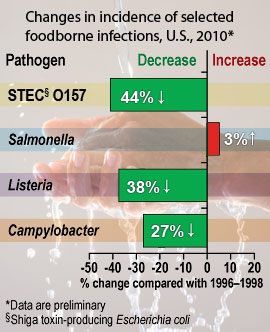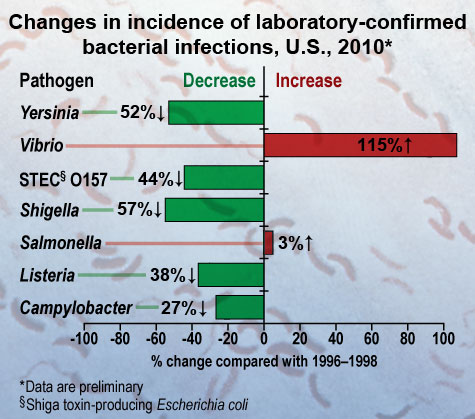Incidence of Foodborne Illness, 2010
Food safety is important year round. CDC is highlighting foodborne illness data. Whether you're on vacation or cooking at home, please keep food safety in mind.
 The Foodborne Diseases Active Surveillance Network (FoodNet) is the principal foodborne disease component of CDC's Emerging Infections Program (EIP). FoodNet is a collaborative project of the CDC, 10 state health departments (California, Colorado, Connecticut, Georgia, Maryland, Minnesota, New Mexico, New York, Oregon, and Tennessee), the U.S. Department of Agriculture (USDA), and the Food and Drug Administration (FDA).
The Foodborne Diseases Active Surveillance Network (FoodNet) is the principal foodborne disease component of CDC's Emerging Infections Program (EIP). FoodNet is a collaborative project of the CDC, 10 state health departments (California, Colorado, Connecticut, Georgia, Maryland, Minnesota, New Mexico, New York, Oregon, and Tennessee), the U.S. Department of Agriculture (USDA), and the Food and Drug Administration (FDA).
Foodborne diseases monitored through FoodNet include infections caused by the bacteria Campylobacter, Shiga toxin-producing Escherichia coli (STEC), Listeria, Salmonella, Shigella, Vibrio, and Yersinia, and the parasites Cryptosporidium and Cyclospora. In 1996, FoodNet surveillance began in Minnesota, Oregon, and in selected counties in California, Connecticut, and Georgia. Since then the surveillance area has expanded to include the states of Connecticut, Georgia, Maryland, Minnesota, New Mexico, Oregon, Tennessee, and selected counties in California, Colorado, and New York. In 2010, the FoodNet surveillance area covered a population of approximately 46 million persons, or 15% of the United States population.
FoodNet conducts active surveillance for foodborne diseases and related epidemiologic studies designed to help public health officials better understand the epidemiology of foodborne diseases in the United States. FoodNet also provides a network for responding to new and emerging foodborne diseases, monitoring the burden of foodborne diseases, and identifying the sources of specific foodborne diseases. Most importantly, FoodNet surveillance provides the data necessary for measuring the progress in foodborne disease prevention.
To estimate changes in incidence of laboratory-confirmed infections in 2010 compared with the average annual incidence in 1996-1998, a main-effects, log-linear Poisson regression (negative binomial) model is used. The model accounts for site-to-site variation and changes over time in the size of the population under surveillance in FoodNet.
In comparison with the 1996–1998 period, rates of infection in 2010 were lower for Shigella (57% decrease), Yersinia (52% decrease), STEC O157 (44% decrease), Listeria (38% decrease), and Campylobacter (27% decrease); slightly higher for Salmonella (though not significantly different); and significantly higher for Vibrio (115% increase).
Consumers can reduce their risk for foodborne illness by following safe food-handling and preparation recommendations, and by avoiding consumption of raw or undercooked foods of animal origin such as eggs, ground beef, and poultry; unpasteurized milk; and raw or undercooked oysters.
Food preparers should follow the easy lessons of "Clean, Separate, Cook, and Chill":
Clean. Wash hands, cutting boards, utensils, and countertops.
Separate. Keep raw meat, poultry, and seafood separate from ready-to-eat foods.
Cook. Use a food thermometer to ensure that foods are cooked to a safe internal temperature: 145°F for whole meats (allowing the meat to rest for 3 minutes before carving or consuming), 160°F for ground meats, and 165°F for all poultry.
Chill. Keep your refrigerator below 40°F and refrigerate food that will spoil.
Report suspected illness from food to your local health department.
Don't prepare food for others if you have diarrhea or vomiting.
Be especially careful preparing food for children, pregnant women, those in poor health, and older adults.

More Information
- Foodsafety.gov
- FoodNet (Foodborne Diseases Active Surveillance Network)
- CDC's Vital Signs
- CDC's Division of Foodborne, Waterborne, and Environmental Diseases
- CDC's Food Safety Office
- Food Safety is a CDC Winnable Battle
- CDC's Estimates of Foodborne Illness in the United States
- President's Food Safety Working Group
- Fight BAC! Partnership for Food Safety Education
- United States Department of Agriculture (USDA)
- United States Food and Drug Administration (FDA)
CDC works 24/7 saving lives and protecting people from health threats to have a more secure nation. A US federal agency, CDC helps make the healthy choice the easy choice by putting science and prevention into action. CDC works to help people live longer, healthier and more productive lives.
Get email updates
To receive email updates about this page, enter your email address:
Contact Us:
- Centers for Disease Control and Prevention
1600 Clifton Rd
Atlanta, GA 30333 - 800-CDC-INFO
(800-232-4636)
TTY: (888) 232-6348 - Contact CDC-INFO



